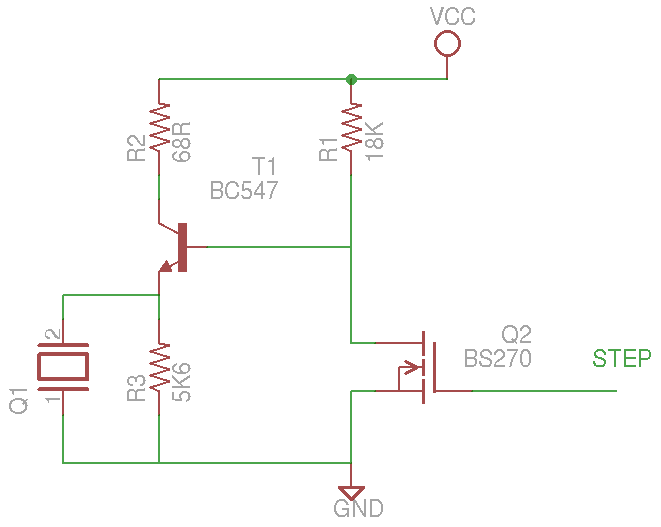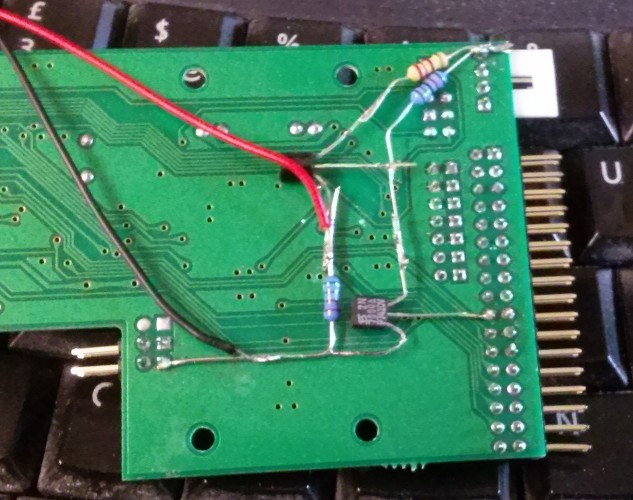The circuit I cobbled together a few weeks ago to add sound support to the Gotek floppy emulator worked up to a point, but it was ugly as hell, and suffered from occasional stray oscillations. H.M. – the mastermind behind the new Amiga-compatible firmware for the Gotek unit – suggested using a MOSFET instead of the BJTs, and since I’m still shaky on the use of transistors it seemed like a good opportunity to learn.
I must confess that my component selection process looks something like this:
- Find a component which will do the job
- Check EBay – is it easily and cheaply obtainable?
- No? Go to step 1
- Yes? Done!
I wanted a small MOSFET that would comfortably switch a low current 12 volt load, triggered by a signal that sits at around 3v most of the time, and drops down to something approaching zero-volts momentarily when the drive head steps. In particular I was looking for a device with a switching threshold voltage between 1v and 3v – any lower than this and there’d be a danger that the step pulses wouldn’t actually trigger the transistor. I settled on 2 devices to try – 2N7000 and BS270.
From the Googling I’ve done since starting this project, I’ve learned that piezo sounders don’t like having a constant voltage across them in the long term – so my goal for the revisited circuit is to have zero potential across the sounder except when a step pulse is happening. The obvious way to achieve this is to have the sounder in series with a resistor, from VCC to GND, with the MOSFET across the sounder. Since the step signal is active low, this should work in theory – but in practice it doesn’t! The reason is that the step pulse is too narrow (nominally 1µs, though in practice not quite that brief) to provoke a response from the sounder.
To get around this, I chained the MOSFET with a good old BC547, with its lengthy storage time measured in the hundreds of microseconds. This significantly widens the pulse and makes it audible.
I’m still “rat’s-nesting” the circuit, but this simplified version is significantly neater than my first attempt!



Thank you. This is great. I’ll try as soon as i get the materials.
Good luck 🙂 Just note that the photo shows a 2N7000 for the MOSFET, not BS270. A BS270 will work, but will need to be the other way up (flat side down).
I picked up a Gotek, was able to get it work for two days, but now the button selectors will not switch up or down. Is there a way to reset the device to get it out of being stuck in this mode? I am stuck on disk image 1 and unable to select 000 to get back to the menu. I’m working with a basic Amiga 500.
Have you tried a different USB stick? I think the current “state” is stored on the stick, and I have seen a drive get confused when I replaced an ADF with a newer version. You can also try momentarily shorting the reset jumper on the programming header. (See the cortexamigafloppydrive page for an indication of which pins to bridge.)
I’ve noticed that the current firmware hates it if you replace an ADF with a new version, and has a habit of getting stuck as you describe. To clear it, hold down both buttons at power-on. That should force it to select slot 000 which is the selector.
I don’t know if this is still relevant.. but the reason for this is the current start cluster is stored within the Selector.ADF file itself.
So when you change an ADF around on a FAT partition the start cluster will change upsetting the Selector.adf
Hi! Thanks a lot for the info! Could you write a list of components required so we can seek for them even on eBay?
Thanks a lot
Sure:
1 piezo sounder, 35mm is the size I normally use.
1 BC547 bipolar transistor
1 2N7000 MOSFET transistor (this is the one shown “face up” in the photo)
1 18 KOhm resistor (the blue one top right in the photo)
1 5K6 resistor (the blue one at the bottom in the photo)
1 68 Ohm resistor (the tan coloured one at the top in the photo)
Hi
Thanks for the great HowTo. Can i take your Schematics and post it to my own Webpage? I don’t simply copy your image, i make my own. And of course, I write your name/copyright next to the image. I would greatly appreciate it
Yes, certainly, feel free!
Thank you! 🙂